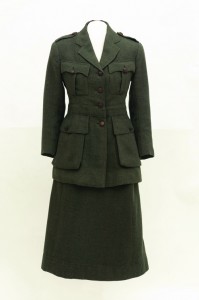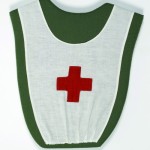Cumann na mBan
Published in Artefacts, Issue 3 (May/June 2014), Volume 22The notes of a Cumann na mBan convention held in Dublin on 31 October 1915 record that:
‘A uniform was adopted and it was resolved that the use of the uniform be optional, but that none other be adopted by branches. It consists of a coat and skirt of Volunteer tweed and hat of same. Four pockets in coat, skirt at least seven inches off the ground, tweed or leather belt, haversack with first aid outfit. A grey or green felt hat and a haversack are recommended where uniform is not possible. Members of Cumann na mBan are in honour bound to give preference, when purchasing, to goods of Irish manufacture.’

Cumann na mBan uniform (jacket and skirt) worn by Helena (Nellie) Hoyne. (NMI)
The National Museum of Ireland’s (NMI) collections contain several examples of the resulting uniform, as worn by Helena (Nellie) Hoyne, Rose McNamara and Annie Cooney. In her witness statement, given to the Bureau of Military History (BMH) in 1950, Peig Conlon recalled that ‘Some of us made our own uniforms. Mrs Clarke gave us instructions about cutting them out. She cut out mine.’ A uniform formerly on loan to the NMI and returned to its owner in 1952 bore a label stating that the tunic and skirt had been ‘made in Dublin by Co-Op Workers’. Peig Conlon also recorded that she and other members of the Fairview (Caitlín Ní hUallacháin) branch were instructed in first aid by Dr Kathleen Lynn and Dr McGrath, and were taught to shoot with a rifle by a former British soldier called Ryan. Signalling, drill and marching were also taught in this and other branches around the country.
Despite the military nature of the instruction received by branch members, the organisation was essentially a non-combatant auxiliary corps to the Irish Volunteers. During the inaugural meeting of Cumann na mBan, held in Wynn’s Hotel on 5 April 1914, the group’s objectives made this support role very clear: to advance the cause of Irish liberty; to organise Irishwomen in furtherance of this object; to assist in arming and equipping a body of Irish men for the defence of Ireland; and to form a fund for these purposes, to be called the ‘defence of Ireland fund’. This subsidiary role led to a charge of ‘crawling servility’ from Francis Sheehy Skeffington, an opinion echoed by other feminists in the Irish Women’s Franchise League. Cumann na mBan’s defence was that there could be ‘no free women in an enslaved nation’.

Red Cross apron worn by Eva Burke in the GPO during Easter Week. (NMI)
During the 1916 Rising, first-aid posts were established by Cumann na mBan women in most of the Dublin garrisons. The NMI’s Easter Week Collection contains a Red Cross armlet and apron worn in the GPO by Eva Burke, as well as an armlet worn at the same first-aid station by Tilly Simpson. Also part of the collection are elements of the first-aid outfit used by Mary O’Sullivan during Easter Week and a satchel given to Christina Hayes by Commandant Edward Daly when he put her in charge of the Father Mathew Hall first-aid station. A number of these items are on display in the ‘Soldiers and Chiefs: Irish Soldiers at Home and Abroad since 1550’ exhibition at the NMI, Collins Barracks.
Sandra Heise is Curator of the Easter Week and Historical Collections at the National Museum of Ireland, Collins Barracks.
















